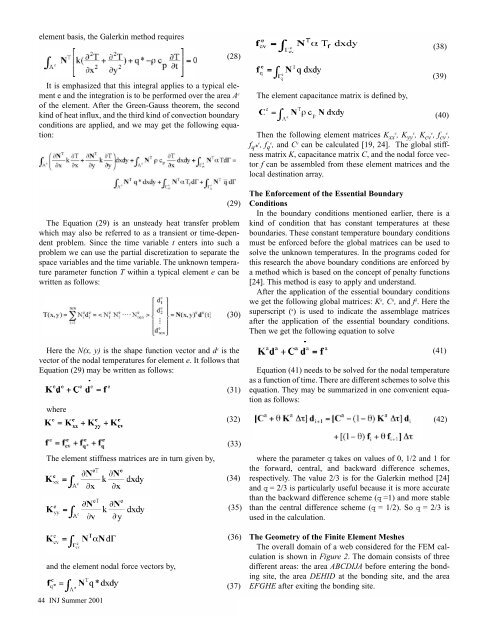2001 - Volume 2 - Journal of Engineered Fibers and Fabrics
2001 - Volume 2 - Journal of Engineered Fibers and Fabrics
2001 - Volume 2 - Journal of Engineered Fibers and Fabrics
Create successful ePaper yourself
Turn your PDF publications into a flip-book with our unique Google optimized e-Paper software.
element basis, the Galerkin method requires<br />
(28)<br />
(38)<br />
It is emphasized that this integral applies to a typical element<br />
e <strong>and</strong> the integration is to be performed over the area A e<br />
<strong>of</strong> the element. After the Green-Gauss theorem, the second<br />
kind <strong>of</strong> heat influx, <strong>and</strong> the third kind <strong>of</strong> convection boundary<br />
conditions are applied, <strong>and</strong> we may get the following equation:<br />
The Equation (29) is an unsteady heat transfer problem<br />
which may also be referred to as a transient or time-dependent<br />
problem. Since the time variable t enters into such a<br />
problem we can use the partial discretization to separate the<br />
space variables <strong>and</strong> the time variable. The unknown temperature<br />
parameter function T within a typical element e can be<br />
written as follows:<br />
Here the N(x, y) is the shape function vector <strong>and</strong> d e is the<br />
vector <strong>of</strong> the nodal temperatures for element e. It follows that<br />
Equation (29) may be written as follows:<br />
where<br />
(29)<br />
(30)<br />
(31)<br />
(32)<br />
The element capacitance matrix is defined by,<br />
(39)<br />
(40)<br />
Then the following element matrices K xxe ,K yye ,K cve ,f cve ,<br />
f q*e ,f qe<br />
, <strong>and</strong> C e can be calculated [19, 24]. The global stiffness<br />
matrix K, capacitance matrix C, <strong>and</strong> the nodal force vector<br />
f can be assembled from these element matrices <strong>and</strong> the<br />
local destination array.<br />
The Enforcement <strong>of</strong> the Essential Boundary<br />
Conditions<br />
In the boundary conditions mentioned earlier, there is a<br />
kind <strong>of</strong> condition that has constant temperatures at these<br />
boundaries. These constant temperature boundary conditions<br />
must be enforced before the global matrices can be used to<br />
solve the unknown temperatures. In the programs coded for<br />
this research the above boundary conditions are enforced by<br />
a method which is based on the concept <strong>of</strong> penalty functions<br />
[24]. This method is easy to apply <strong>and</strong> underst<strong>and</strong>.<br />
After the application <strong>of</strong> the essential boundary conditions<br />
we get the following global matrices: K a ,C a , <strong>and</strong> f a . Here the<br />
superscript ( a ) is used to indicate the assemblage matrices<br />
after the application <strong>of</strong> the essential boundary conditions.<br />
Then we get the following equation to solve<br />
(41)<br />
Equation (41) needs to be solved for the nodal temperature<br />
as a function <strong>of</strong> time. There are different schemes to solve this<br />
equation. They may be summarized in one convenient equation<br />
as follows:<br />
(42)<br />
The element stiffness matrices are in turn given by,<br />
y<br />
<strong>and</strong> the element nodal force vectors by,<br />
44 INJ Summer <strong>2001</strong><br />
(33)<br />
(34)<br />
(35)<br />
(36)<br />
(37)<br />
where the parameter q takes on values <strong>of</strong> 0, 1/2 <strong>and</strong> 1 for<br />
the forward, central, <strong>and</strong> backward difference schemes,<br />
respectively. The value 2/3 is for the Galerkin method [24]<br />
<strong>and</strong> q = 2/3 is particularly useful because it is more accurate<br />
than the backward difference scheme (q =1) <strong>and</strong> more stable<br />
than the central difference scheme (q = 1/2). So q = 2/3 is<br />
used in the calculation.<br />
The Geometry <strong>of</strong> the Finite Element Meshes<br />
The overall domain <strong>of</strong> a web considered for the FEM calculation<br />
is shown in Figure 2. The domain consists <strong>of</strong> three<br />
different areas: the area ABCDIJA before entering the bonding<br />
site, the area DEHID at the bonding site, <strong>and</strong> the area<br />
EFGHE after exiting the bonding site.
















